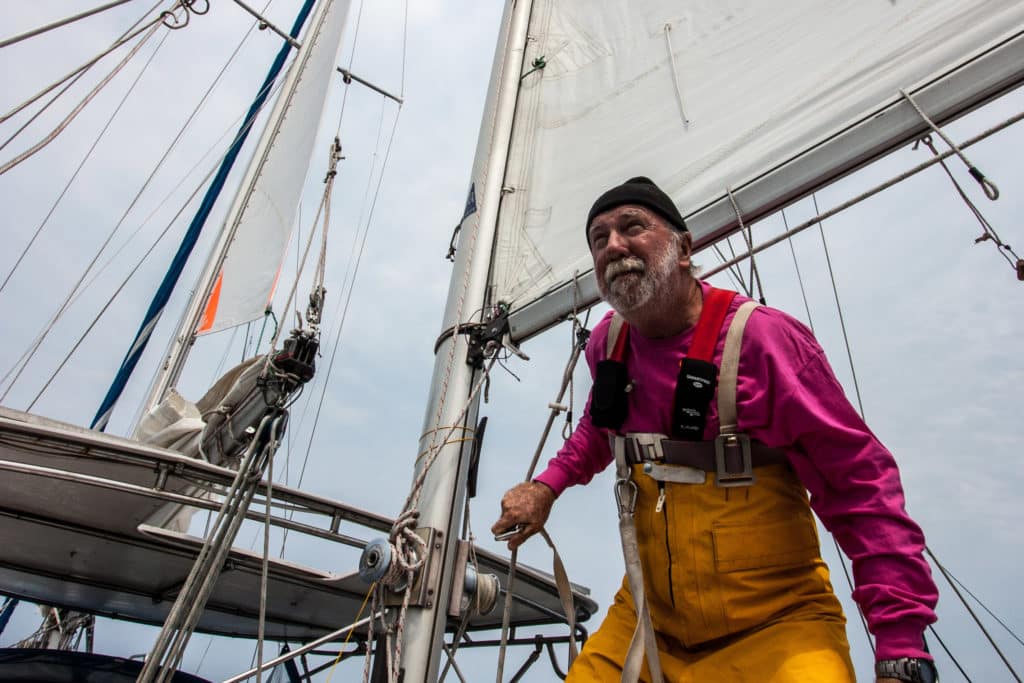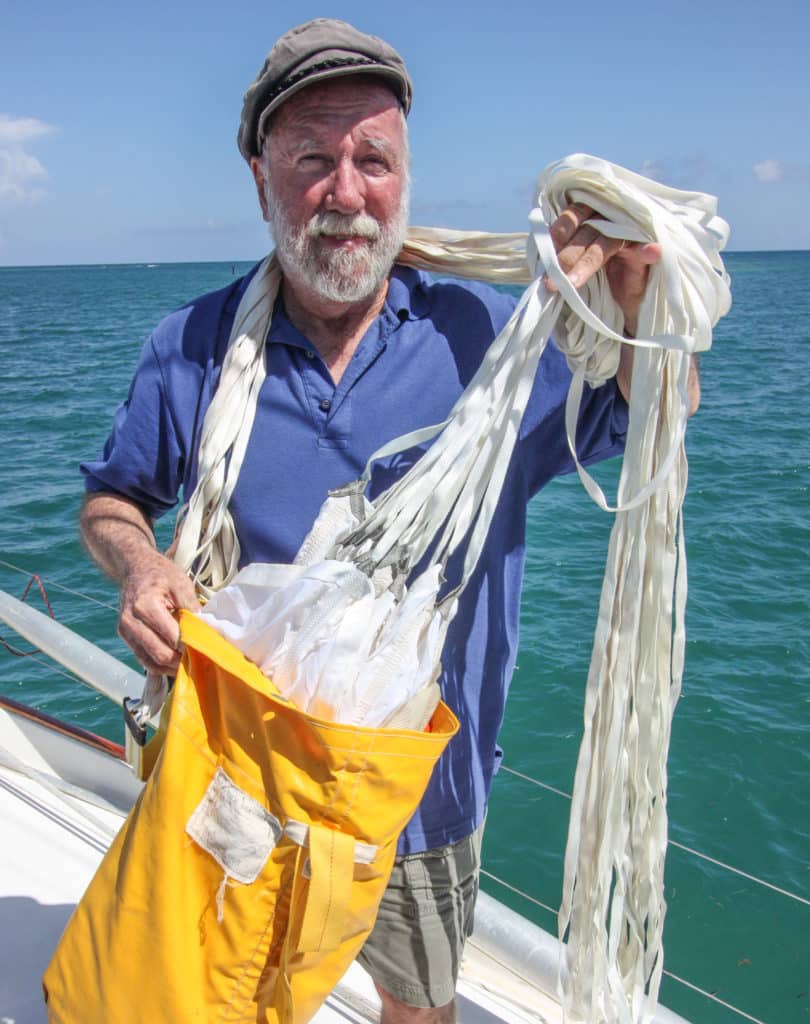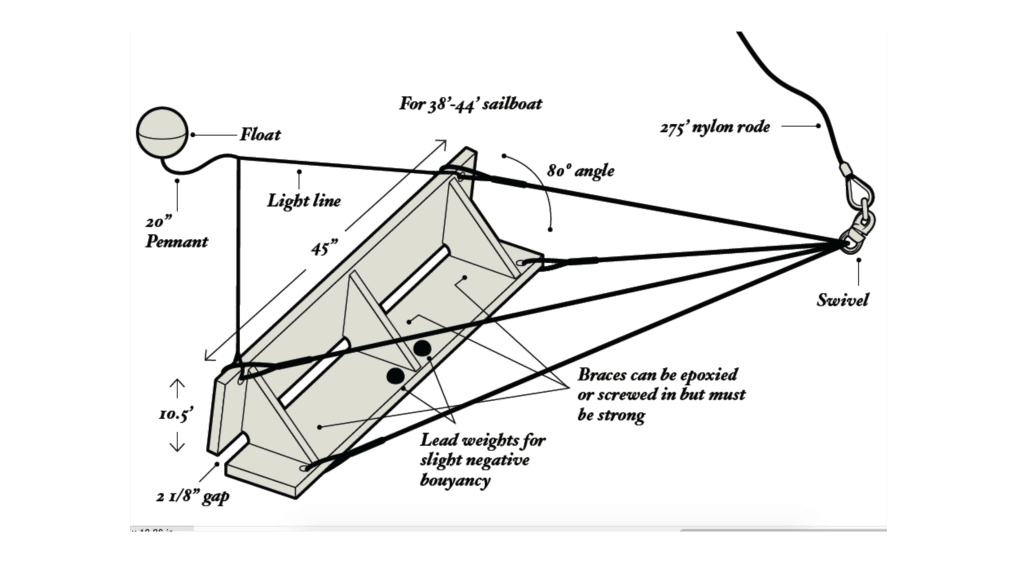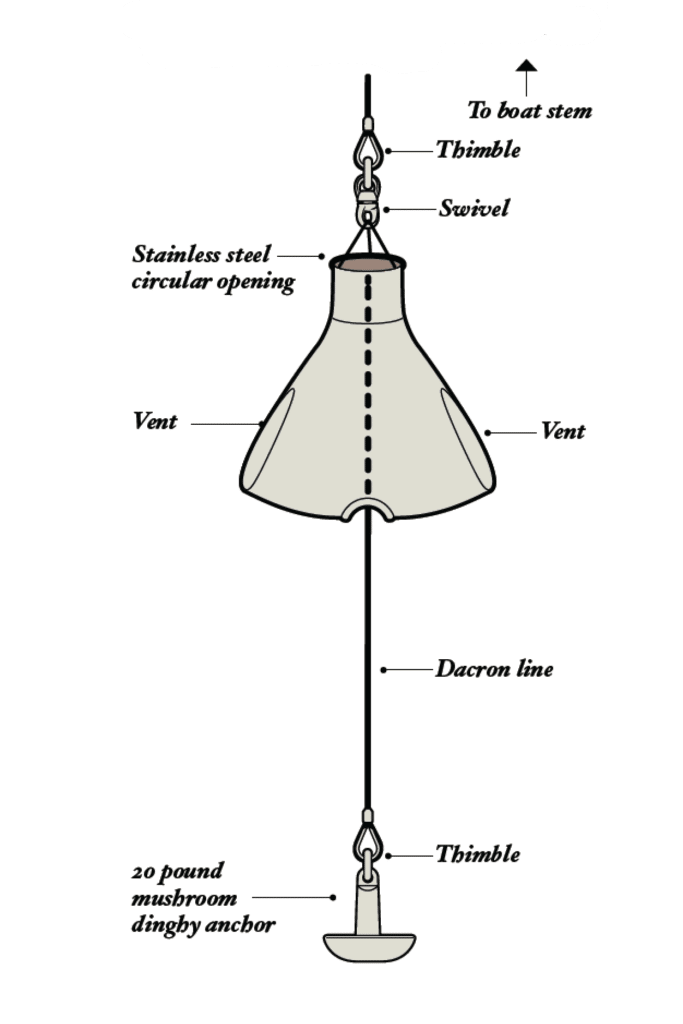
While growing up aboard the schooner Elizabeth in the 1950s, I used to swing through the rig, much to the disgust of the timid adults ashore. I loved being aloft. I felt comfortable there, like a proud frigate bird surveying the ocean.
Once, in St. Petersburg, Florida, while standing atop our starboard ratlines, I noticed a blue kite stuck in a tree in nearby Vinoy Park. We were poor; I had no toys, and kites were fun. So I quickly slid down our galvanized shrouds, leapt onto the dock of slip No. 7 and dashed across the street.
It was tricky because the kite was caught at the very top of a large banyan, but I eventually managed to get it down. Alas, it wouldn’t fly. Again and again, I tried to launch it, and it would just spin out of control. I soon became frustrated, but fortunately, my brother-in-law, the Gyroaster, came by. He was a giant of a man, and handsome as heck. My sister, Gale, would melt when he was around. Yuck! Actually, you’ve probably seen him — he was the Marlboro Man for many years. And anyway, he knew a lot of stuff.
“You need a tail,” he said, as he returned to his pickup truck and ripped up a greasy T-shirt.
Once a few knotted strips of fabric hung from the kite, it was a totally different beast. It flew sweetly. I had perfect control. I’ve never forgotten that day.
At the beginning of our third circumnavigation, this one aboard Ganesh, our new-to-us and unfamiliar ketch-rigged Amphitrite 43, I quickly realized that my learning curve would have to be steep. Ganesh behaved completely differently than our previous S&S-designed Hughes 38, Wild Card. Gusts over 30 knots would send our old boat zooming like a scalded cat; ditto for large, breaking seas. Once we did 150 miles in 24 hours under bare poles using our Monitor self-steering device, and Wild Card felt like she was on rails.
In a blow, Ganesh was different.
Way different.
Off the coast of Colombia, with an apparent wind of 34 knots and a speed of 8 knots, Ganesh was beginning to scare me, and I don’t like to be scared. Worse, I could see that look of concern that my wife, Carolyn, had in her eyes. “She’s really, um, slewing, isn’t she?” Carolyn noted.
Since a large part of seamanship consists of stoically observing, I began watching the building seas with great attention.
In the troughs, Ganesh was fine. She’d point dead downwind. But as a wave picked her up and she accelerated down its foaming face, she’d start frantically hunting. The further off course she became, the more her bow would dig in, the less effective her rudder would be, and the more she’d want to carve out like a runaway surfboard. It was disconcerting, this uncomfortable feeling that our transom might attempt to pass our bow. What if we got sideways to the seas? Would all 15 tons of her broach?
I didn’t want to find out.
One solution would have been to heave-to, but we were making great time and pointing directly at the Panama Canal. I hated to stop her. Sure, it would be safer, but these heavy wind and sea conditions would last all week. I didn’t want to heave-to for five to eight days. I wanted to keep moving.
The towing of warps is an old trick. So I took a 150-foot-long anchor line and connected its end to my port cleat, led it through my strong aft chock and lowered the bight into the water. At first there was almost no pressure, but as I paid out the line, the drag increased. When I came to the end of the line, I cleated it off on the starboard aft cleat. Now I had a large bight of line 75 feet astern. It didn’t do much of anything, but took about a quarter of a knot off my speed.
I watched and watched and thought and thought. That’s all heavy-weather management is, really, just experiencing and seeing what happens, which, in this case, wasn’t much.
Next, I took one of our fenders with a stout line on it, tied a bowline around the bight of line, and tossed the fender into the water. It ran aft and stopped, and I immediately felt a difference. I added a second fender. Even better! Now we weren’t slewing around nearly as much. However, occasionally both fenders were yanked out of the water and would start skipping over the waves. When they did, we’d slew badly until they bit in again.
I watched.
Next I relieved the pressure on the port end of the dragging line with a rolling hitch and short length of line secured on board. I tied the bitter end of another anchor line to the first, then cast off the rolling hitch.
The added length of line paid out, and now my two fenders were trailing 150 feet aft, and coming out of the water far less. I let her ride like this for a while as the sea continued to build. I decided we needed more drag, so I tied another two fenders onto the line — and then extended it with another rode.
Now I had four fenders 300 feet aft. And I watched.
Next, I adjusted the length of my towline until all four fenders sat directly behind one of the waves, completely out of my sight. I reached down and felt the moderate strain. Suddenly a huge breaking sea approached, Ganesh started to surf off, the towline load spiked dramatically and all four fenders were completely pulled though the wave, from backside to front, and then dug anew.
I knew I had the right idea when Carolyn appeared in the companionway with her novel and asked, “Is it calming down?”
There was no longer any tendency for Ganesh to get squirrelly. I wasn’t scared of broaching, and our speed was still averaging around 6½ knots.
Each storm is different, and thus, a skipper needs flexibility in his decision-making. This requires having the correct gear and knowing how to deploy it.
I’d put a tail on my kite. I was in perfect control.

One time, we came out of New Zealand with a perfect weather window — not! A major gale was on the way, in the same area as the infamous and fatal 1994 Queen’s Birthday storm. Yes, there was a squash zone involved this time too. Even the Kiwi skippers I heard on the radio were getting nervous, which is enough to make any sane sailor gulp. When a Kiwi or South African sailor says, “There’s a bit of breeze on the way,” that means you should check your last will and testament.
The whole reason I carry a Para-Tech sea anchor and a Jordan Series Drogue is so I have options in an ultimate storm. Was this one? I wasn’t certain, but I decided to deploy one or the other slowing device just in case. If I’d wanted to make speed downwind and stay with the system, I’d have deployed the series drogue, my experimental homemade fat-bag or my webbing drogue. However, the last thing I wanted to do was travel with this particular storm. I wanted to remain in it for the shortest time possible, so I decided to set my Para-Tech sea anchor off the bow so we could park and let the storm pass by.
I heaved to and rigged the Para-Tech’s retrieval line exactly as recommended. Next, I ran a 400-foot nylon rode from the aft deck, outside the stanchions (tied with yarn to keep it from unraveling) and up to the bow. Here’s the sobering truth of it: People occasionally get severely injured while deploying or retrieving large parachute-type anchors. It’s dangerous. The ads don’t tell you this, but it is. Once that parachute is in the water, your vessel might as well be shackled to a block of granite on the bottom. Thankfully, we had no problem deploying ours from our nearly stationary position.
Once the sea anchor took up and I’d doused our storm trysail, it was just like being anchored in 20-foot swells. Of course, our masthead was scribing large arcs in the sky and we were rolling violently from rail to rail. At first, we took to our bunks, Carolyn green at the gills. Gradually, we started crawling around on the cabin sole. Twenty-four hours later, Carolyn was making bread while I was jammed in a corner, playing guitar. We felt perfectly safe, if not comfortable.
Luckily (actually, luck had nothing to do with it) we’d removed both the anchors that normally live on our bow, as well as all our chain. These were now tied inside our boat to our mast base. Our boat’s ends were as light as we could make them. Thus she rode the giant waves like a swan.
Every two hours, day and night, I’d change the chafe point on the Para-Tech’s rode. That sounds easy, but it wasn’t; not when the line was shock-loaded with 5,000 pounds or so.
Here’s how I did it: I donned my foulies and sea boots, put on my safety harness, grabbed a crowbar and carefully made my way forward. (Picture crawling on the back of a rearing stallion in pitch-black darkness and you’re close to seeing me move about on deck.)

Once at the bitts, I made sure the 40 or 50 feet of extra rode was all in front of me, so if it got away, I wouldn’t be killed instantly. Then I paused and said to myself, “Fatty, this is what you came for. This is all part of it. But if you lose control of this line or end up in the water, you’re dead. Right now you’ve got 10 fingers. Let’s keep it that way.”
That’s exactly how it happened. I actually whispered that to myself. Some people think I have no fear; that’s silly. Everyone has fear. Life is precious. The trick isn’t to ignore your fear but rather to harness it.
And that’s what I did. I loosened up the line on the cleat, working gingerly, like I was playing with a bomb that could blow any second. More and more I loosened the line until any more loosening might allow it to come off the cleat. Then I carefully stuck my crowbar into the final crisscross of line and wiggled it. Instantly, with a sickening snap tightening sound, the line on the cleat slipped and took up once again.
I’d changed the chafe point by about an inch with complete control.
A little over two days later, the wind had gone down but the seas were still high. The smart thing to do was to stay put, but alas, another storm was spinning off the Tasman between Australia and New Zealand, and if we didn’t set sail we’d have to stay parked for another four days or so.
Thus, we decided to retrieve the sea anchor and try to get northward out of the worst of the weather.
What happened next, well, I still start whimpering just remembering it.
First off, my good friend and sailing hero Larry Pardey had once advised me to remove the retrieval line on the Para-Tech. “They never work, and they often get in the way,” he said. “Trust me, Fatty, just cut it off.”
On the other hand, the manufacturer of the unit said folks successfully use the retrieval line all the time.
So, I decided to try it. I followed all the instructions as faithfully as I could. In theory, the retrieval line collapses the parachute, making it easier to haul back aboard. But when I went to actually use it in battle conditions, it was totally useless: completely snarled in a jumbled mess.
Score one for Larry.
As mentioned, the sea was rougher than I would have liked, and I have one more confession, dear reader. My 400 feet of ¾-inch nylon rode wasn’t in one piece. I’m a poor man. Most of my shopping is done at Dumpster Marine. The anchor line was cobbled together from various discarded bits and one new 125-foot piece of black Samson braid.

This can be built of oak, plywood, or fiberglass, but it must be strong. You can make it fold with removable braces and hinges. Tim Barker
Now, I wasn’t worried about my knots coming undone because I’d tied double-carricks and whipped the bitter ends with strong wax twine. But a knot is a lump, and this greatly complicated things. I won’t bore you with a blow-by-blow. Let’s just say getting each knot through the roller chock and around the rope windlass gypsy took about 45 minutes of tying and untying various short rope pennants with rolling hitches. Had any of those knots slipped while shock-loaded, well, bye-bye Fatso.
So here is the reality of the more than three hours that I wrestled with Satan up there on my foredeck: Retrieving my Para-Tech sea anchor was, far and away, the most dangerous thing I have ever done intentionally. In hindsight, I should have cut it loose. But, as mentioned, I’m a poor man, and it is a costly bit of fabric. And, yes, another factor came into play: I’m stubborn and pigheaded as well. I put that damn thing in the water, and I was going to get it back aboard!
Over the next couple of years I became fascinated by slowing devices. It didn’t take long to realize that the ideal one would create little drag at 4 knots and lots of drag at 6 to 8 knots of boat speed. Over the years, many attempts have been made to improve the proverbial mousetrap, and of course, I couldn’t resist the challenge taken up by some of my childhood heroes. My early idol Frederick A. Fenger (father of the wishbone rig) invented the plywood sea anchor, and John Voss came up with various fabric devices during his adventures made famous in The Venturesome Voyages of Captain Voss. I have no doubt that when Ulysses lost an attached sail overboard in a storm, he noticed the calming effect as it trailed behind his ship.
So, I sidled up to the prettiest little seamstress I know, gave her a hug and a smile, and placed a number of drogue designs in front of her.
“The Flat Fat drogue,” I told her, “uses cheap seat-belt material for the webbing and nylon for the slowing flaps, and stows well. The Fat Puffer has slits that bulge as the force of the water increases. And the Fat Web is basically just a bunch of webbing with maximum wetted surface that takes up minimal space.”
Carolyn frowned. I’m always asking her to sew up crazy ideas, most of which don’t work. However, occasionally she adjusts one of my stupid ideas brilliantly — and I steal all the credit. (Well, I’m a man, right?)
Don’t forget, heavy-weather management boils down to controlling two things: angle and speed. A drag device is one of the simplest, most basic ways to achieve this.
Carolyn looked at the various designs and scratched her head. “What’s my budget?”
“The usual,” I said. “Zero.”
She grimaced and gave me a look.
“Hey, babe,” I said. “There’s no challenge in buying one!”
“Darn you, Fatty,” she said, as she hauled her rusty Pfaff sewing machine out of the bilge and began hosing it down with WD-40.
Soon she was hunched over her rattling, jiggling machine, spewing out various drag devices and a brand-new Jordan Series-style drogue (136 cones) for good measure.

As boat speed increases, vents open wider which increases drag. Tim Barker
Perhaps the most important thing to be learned from this article is that “anyone can play,” as my father used to put it. You don’t have to be a scientist or mathematician to tame the elements. The truth is that a spare tire (even a retread) tied astern can save your life in certain conditions.
To put it another way, I may have sailed around the world twice on a $3,000 boat — but Wild Card had far more safety gear aboard than some of the $3 million yachts sailing next to me.
Why not heave-to in a storm? I do. I love to heave-to. It is a basic skill of any offshore sailor. But sometimes I want to keep moving for various reasons, perhaps to sail out of a strong (and dangerous) ocean current, for example. I want options, lots of options. I need flexibility to survive offshore year after year. And, frankly, my boat is usually fine heaved-to in up to 45 knots. However, if I get a 70-knot gust, will my sail track pull out or the gooseneck shatter or sheet break? I don’t know. And I don’t want to find out in hurricane-force winds.
As Carolyn and I endlessly voyage, we’ve found that I like places she doesn’t. Take Namibia’s Skeleton Coast, for example. There are odd currents, fierce storms and dangerously shifting sandbars. It’s a perfect place for an adventurous soul like me. “And how, exactly, did this area get its name?” Carolyn asked as we sailed Ganesh northward along its dramatic West African coast of shifting desert sands.
“From all the wrecks of the old sailing ships,” I said. “The vessel frame ends sticking up out of the dunes were easy to spot and kind of eerie. Once the rescuers rowed ashore, they’d then follow the footprints of the thirsty sailors in the sand to find their dehydrated bodies. So, it was kind of a two-for-one skeleton hunt.”
“Oh, lovely,” Carolyn said, rolling her eyes.
We’d gotten a good weather window out of Cape Town. There were a number of cruising vessels within 50 miles on the same passage. We had all tracked the moderate gale sliding toward us from St. Helena. A couple of the crews had real problems in the 40-knot gusty winds. They became fatigued from hand-steering for more than 35 hours in the large breaking seas.
For Carolyn and me, it was a romantic time-out. I set out version No. 4 of my Fat Puffer. It’s a large bag that fills with water and has slits that enlarge and, hopefully, create turbulence in the gusts to break up a wave. I also unrolled our storm staysail. Our Monitor windvane was steering us straight and true. Our AIS transponder was on, ditto our radar. Our new LED tricolor is very bright, so we figured we’d be seen if other vessels were near.
We both went below; only occasionally peeking out to see the majesty of Mother Ocean in a grand mood.
I had a cup of tea, Carolyn opted for a single glass of red wine. We smiled at each other.
“What’s your favorite part of storm-strutting?” she asked.
“You,” I said.
– – –
Cap’n Fatty and Carolyn Goodlander recently completed their third circumnavigation and are restocking in anticipation of setting out to see the world again. The Cap’n is the author of Storm Proofing Your Boat, Gear and Crew.








